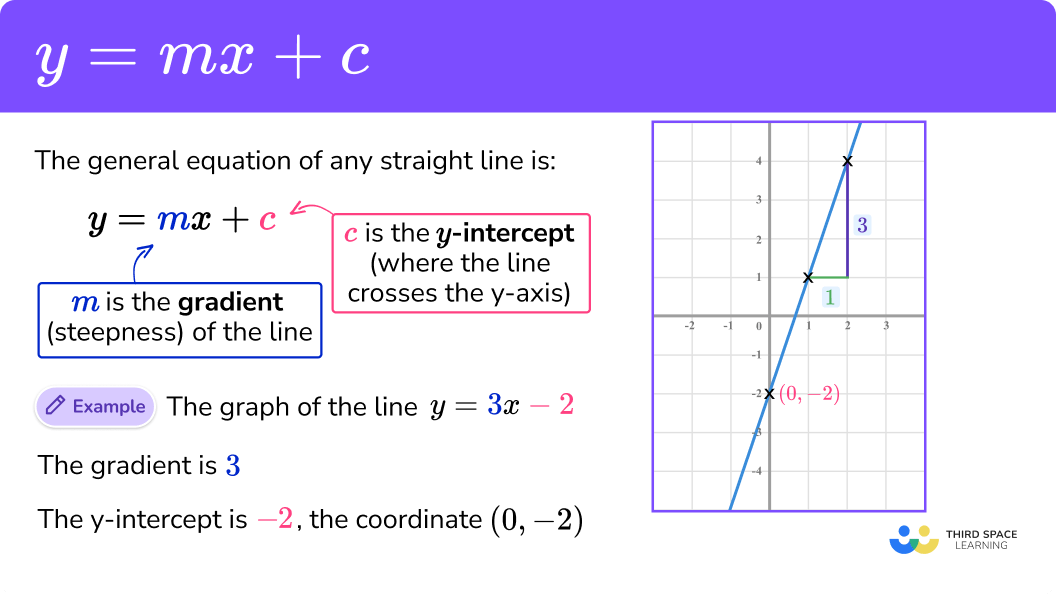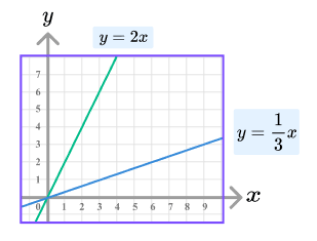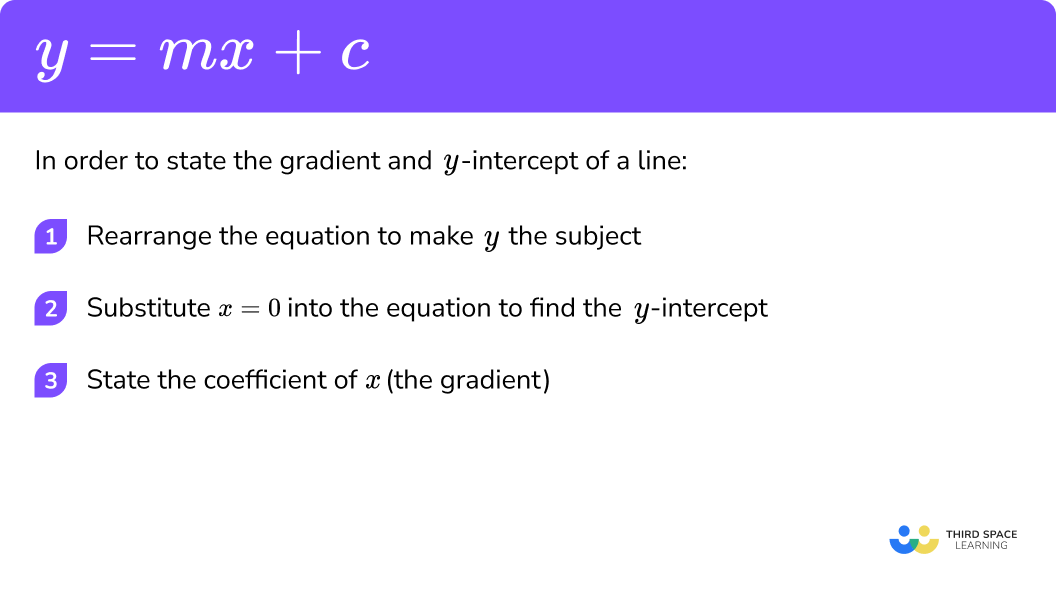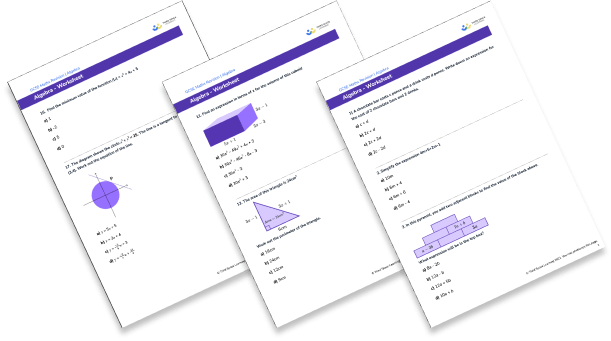GCSE Tutoring Programme
Our chosen students improved 1.19 of a grade on average - 0.45 more than those who didn't have the tutoring.
In order to access this I need to be confident with:
Rearranging equations Negative numbers Fractions Solving equations Plotting graphsThis topic is relevant for:

y=mx+c
Here we will learn about
There are also
What is y=mx+c?
The equation
When we input a value for
This means that
E.g.
Let’s look at the line
This graph has a gradient of 2 and a y-intercept of 1, the coordinate (0,1).
- The term linear is used to describe a straight line where the variables are raised to a power no higher than 1
- If the variables are raised to a power no higher than 2 we refer to it as a quadratic
- If the variables are raised to a power no higher than 3 we refer to it as a cubic, and so on.
What is y=mx+c?

The gradient ‘m’
The gradient of the line tells us how steep the line is. We use the letter
Imagine climbing a ladder. If the ladder is really close to the wall, the gradient of the ladder is really steep (you would almost be climbing vertically). Taking the base of the ladder away from the wall means that the gradient of the slope decreases reaching a lower point on the wall.
The bigger the gradient, the steeper the line.
E.g.
A gradient of
See the diagram below.

The gradient of a line can be many different types of number, i.e. fractions, decimals, negatives etc.
The y-intercept ‘c’
The
E.g.
Let’s look at the equation
To find the
So when
This is the
Here is a quick summary of some equations in the form
How to calculate y=mx+c
In order to calculate the gradient and
- Rearrange the equation to make
y the subject - Substitute
x = 0 into the equation to find they -intercept - State the coefficient of
x (the gradient)
Explain how to use y=mx+c


y=mx+c worksheet

Get your free

y=mx+c worksheet

Get your free
Related lessons on straight line graphs
y=mx+c is part of our series of lessons to support revision on straight line graphs. You may find it helpful to start with the main straight line graphs lesson for a summary of what to expect, or use the step by step guides below for further detail on individual topics. Other lessons in this series include:
y = mx + c examples
Example 1: y=mx+c form
State the gradient and
- Rearrange the equation to make
y the subject
The equation
2Substitute
When
The
3State the coefficient of
The coefficient of
The gradient of the line
Solution:
Example 2: y=mx+c form
State the gradient and
Rearrange the equation to make y the subject
Here we have the two terms of
Substitute x = 0 into the equation to find the y-intercept
When
The
State the coefficient of x (the gradient)
The coefficient of
The gradient of the line
Solution:
Example 3: rearrange the equation when x is the subject
State the gradient and
Rearrange the equation to make y the subject
Here we need to make
Substitute x = 0 into the equation to find the y-intercept
When
The
State the coefficient of x (the gradient)
The coefficient of
The gradient of the line
Example 4: changing the subject including a fraction
State the gradient and
Rearrange the equation to make y the subject
Here we need to make
Substitute x = 0 into the equation to find the y-intercept
When
The
State the coefficient of x (the gradient)
The coefficient of
The gradient of the line
Example 5: changing the subject including brackets
State the gradient and
Rearrange the equation to make y the subject
Here we need to make
Substitute x = 0 into the equation to find the y-intercept
When
The
State the coefficient of x (the gradient)
The coefficient of
The gradient of the line
Example 6: changing the subject including decimals
State the gradient and
Rearrange the equation to make y the subject
Here we need to make
Substitute x = 0 into the equation to find the y-intercept
When
The
is
State the coefficient of x (the gradient)
The coefficient of
The gradient of the line
is
Common misconceptions
- Incorrect inverse operation
When rearranging equations, instead of applying the inverse operation to the value being moved, the value is simply moved to the other side of the equals sign.
E.g.
- Stating the value of
m andc
A common error is to incorrectly state the values of m and c as a result of not rearranging the equation so that it is in form of
Take example
The correct answer for the
- Mixing up the gradient and the y-intercept
Take, for example, the equation
Practice y=mx+c questions
1. State the gradient, m , and y -intercept, c , for the equation
y=-5x+9




The coefficient of x is -5 , so m=-5
When x=0, y=9, so c=9.
2. State the gradient, m , and y -intercept, c , for the equation
y=6-x




y=-x+6
The coefficient of x is -1 , so m=-1
When x=0, y=6, so c=6.
3. State the gradient, m , and y -intercept, c , for the equation
x=2y+5




The coefficient of x is \frac{1}{2} , so m=\frac{1}{2}
When x=0, y=-\frac{5}{2}, so c=-\frac{5}{2}.
4. State the gradient, m , and y -intercept, c , for the equation
3x=5y-6




The coefficient of x is \frac{3}{5} , so m=\frac{3}{5}
When x=0, y=\frac{6}{5}, so c=\frac{6}{5}.
5. State the gradient, m , and y -intercept, c , for the straight line
2x=3(3+y)




The coefficient of x is \frac{2}{3} , so m=\frac{2}{3}
When x=0, y=-3 so c=-3.
6. State the gradient, m , and y -intercept, c , for the equation of the line
0.5x+0.75y=0.25




The coefficient of x is -\frac{2}{3} , so m=-\frac{2}{3}
When x=0, y=\frac{1}{3}, so c=\frac{1}{3}.
y=mx+c GCSE questions
1. Given that the coordinate (3,4) lies on the line y=3x+c calculate the y -intercept of the straight line.
(2 Marks)
Substitute x=3 and y=4 into y=3x+c to get
4=(3\times3)+c (1mark)
(1)
4=9+c so
c=-5 (1mark)
(1)
2. (a) The coordinate A=(0,2) lies on a straight line. The gradient of the line is 5 . Using this information, state the equation of the straight line.
(b) Write the equation of a line that is parallel to a) in the form y=mx+c .
(4 Marks)
(a)
A is the y -intercept so c=2 or when x=0, y=2 so c=2
(1)
y=5x+c (1mark)
(1)
y=5x+2 (1mark)
(1)
(b)
y=5x+c
where
c ≠ 2
(1mark)
(1)
3. Show m=2 for the straight line 8x-4y=12.
(3 Marks)
(3)
Learning checklist
You have now learned how to:
-
reduce a given linear equation in 2 variables to the standard form y=mx+c
The next lessons are
Still stuck?
Prepare your KS4 students for maths GCSEs success with Third Space Learning. Weekly online one to one GCSE maths revision lessons delivered by expert maths tutors.

Find out more about our GCSE maths tuition programme.